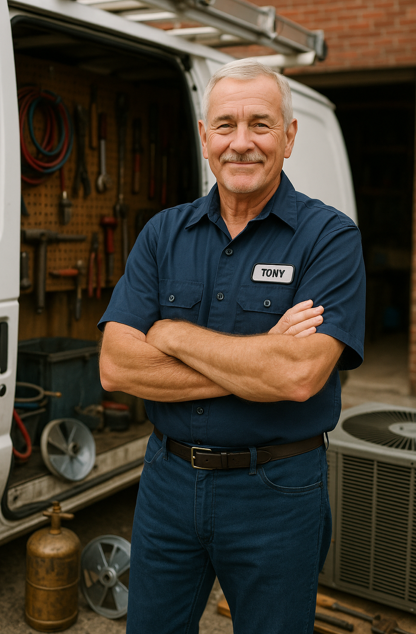What Exactly Is a Packaged or Combo HVAC Unit?
A packaged HVAC system or all-in-one air conditioner combines all major components — compressor, condenser, evaporator, and heater — into a single cabinet, usually placed outdoors on a rooftop or ground pad. These package AC units provide both heating and cooling without requiring an indoor furnace or air handler.
This setup is also called a packaged heating and cooling unit, air conditioner heat pump combo, or electric heater and air conditioner system depending on heating type. The key is convenience — everything is bundled into one compact unit.
For a clear overview, Trane explains that packaged units streamline installation by housing heating and cooling in one cabinet, saving indoor space and simplifying maintenance. (Trane: Packaged HVAC Systems)
Why Choose a Combo or Packaged Unit?
There are some clear advantages to these heater and air conditioner combo units:
-
Easy installation without indoor furnace or duct modifications
-
Space savings for homes or businesses without mechanical closets
-
Simplified maintenance — all components accessible in one box
-
Flexible configurations like gas furnace, electric heat strips, or heat pump options
According to HVAC professionals at Goodman, packaged units are a common choice for commercial buildings, modular homes, and spaces with limited indoor equipment options. (Goodman: Packaged HVAC Systems)
Pros and Cons of Packaged HVAC Units
Pros:
-
Single cabinet design reduces indoor footprint
-
Faster, less invasive installation compared to split systems
-
Easier access for repairs on rooftops or exterior walls
-
Great for commercial spaces, mobile homes, and small residential applications
Cons:
-
Typically noisier than split systems since blower and compressor are co-located
-
Slightly lower energy efficiency, generally rated between 13-16 SEER
-
Limited flexibility for zoning or customization without additional controls
-
Exposed to weather elements, which can impact longevity
HVAC industry experts at ACCA stress that proper duct design and routine maintenance are crucial for packaged system performance and longevity. (ACCA: Packaged Unit Considerations)
Common Sizes and Applications: The 3 Ton Package Unit
One of the most popular sizes for packaged systems is around 3 tons, which suits homes roughly between 1,800 and 2,400 square feet. A 3 ton HVAC package unit can include heat pump or gas furnace heating options alongside cooling.
For smaller spaces, you might consider a 1 ½ ton package unit, popular in mobile or modular homes where indoor mechanical space is limited.
As pointed out by Carrier, packaged units are often found on rooftops of commercial buildings, apartments, and retail stores where indoor equipment placement is difficult. (Carrier: Packaged HVAC Systems)
Cost Breakdown: What to Expect
Packaged HVAC systems typically have higher upfront equipment costs compared to split systems but may save on installation due to their all-in-one design. Here’s a rough breakdown:
-
Equipment cost: $3,500 to $5,500 for a 3-ton packaged unit
-
Installed price: $6,500 to $9,500 including labor, ductwork modifications, permits, and controls
These numbers can vary widely based on brand, climate zone, and installation complexity. Keep in mind that packaged units usually have slightly lower efficiency, so energy costs may be higher over time.
Goodman 3 Ton Split Bundle vs. Packaged Units: What’s Best?
Goodman’s popular 3 Ton 14.5 SEER2 R-32 bundle is a split system, meaning it separates the outdoor condenser from the indoor air handler or furnace. This setup often offers:
-
Quieter operation
-
Higher efficiency
-
Greater flexibility for zoning and indoor air quality upgrades
The Furnace Outlet recommends Goodman’s split systems for most homeowners seeking reliability and long-term value. For more on Goodman’s systems, visit the product page. (The Furnace Outlet Goodman 3 Ton Bundle)
Installation and Maintenance Tips
Regardless of system type, proper installation is vital. For packaged units:
-
Ensure proper pad or rooftop support
-
Confirm correct duct sizing and airflow
-
Check electrical and gas hookups comply with local codes
-
Maintain clean filters and coils regularly
-
Schedule annual inspections to catch wear from weather exposure
Energy Star offers a comprehensive guide on HVAC maintenance best practices to maximize system life. (Energy Star HVAC Maintenance)
Final Thoughts from Tony Marino
If indoor space is tight or you want a simple, all-in-one heating and cooling unit, packaged HVAC systems are a solid choice — especially for commercial buildings or modular homes.
But for residential comfort, quiet operation, and energy savings, Goodman’s proven split system 3 Ton 14.5 SEER2 R-32 bundle often wins. It offers long-term reliability, flexibility, and upgrade potential that packaged units can’t match.
Whatever you decide, professional sizing and installation by qualified HVAC technicians is key. Feel free to reach out if you want expert help comparing options or quotes.
Stay comfortable and smart.
— Tony Marino







